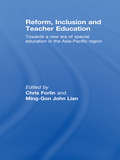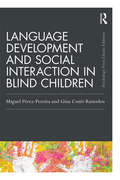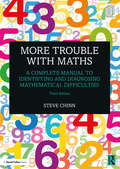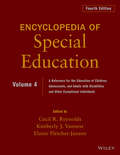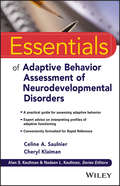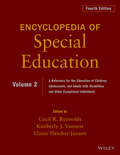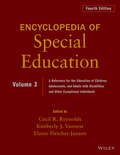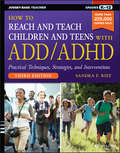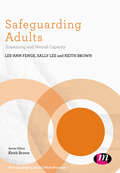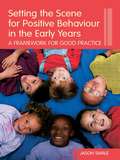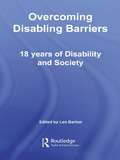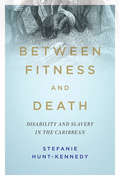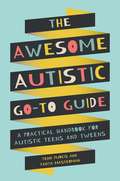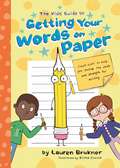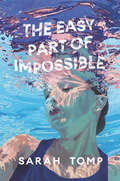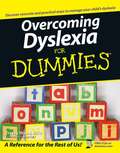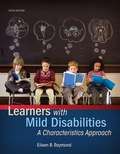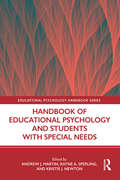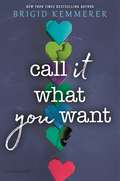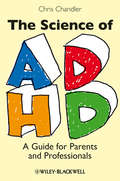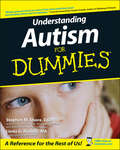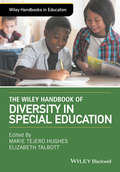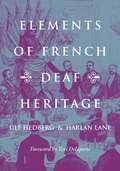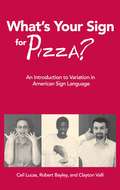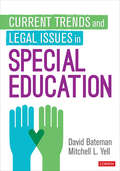- Table View
- List View
Reform, Inclusion and Teacher Education: Towards a New Era of Special Education in the Asia-Pacific Region
by Chris Forlin Ming-Gon John LianThis ground-breaking book considers current perspectives on special education reform in the Asia-Pacific region. It has a major focus on a new era of special education, and how this relates to education reform towards inclusive education. With major changes being proposed under current educational reform and confusion as to how to instigate these measures, this book provides ways to better prepare teachers. It is helpfully divided into three different sections of education reform: "Education Reform in the Asia-Pacific region" reviews broad trends and issues in special education across the region, including Taiwan, Korea, Australia, India, China and Hong Kong. "Preparing Teachers to work in Inclusive Classrooms" focuses on curricula and pedagogical practices for teacher education. This section considers different approaches to preparing teachers such as cross-categorical, collaborative, innovations, and the impact of teachers’ attitudes, perceptions and concerns on inclusion. "Effective Special & Inclusive Practices" draws upon evidence–based research to provide best practice models to assist in developing inclusive school communities. Each section addresses a list of objectives and questions; suggests best practice pedagogy; and concludes with a support section with useful websites and suggested professional development activities. This book will interest teachers, teacher educators, university lecturers in education and post graduate students.
Language Development and Social Interaction in Blind Children (Psychology Press & Routledge Classic Editions)
by Gina Conti-Ramsden Miguel Perez-PereiraThe Classic Edition of this foundational text includes a new preface from Miguel Pérez-Pereira, examining how the field has developed since first publication. The volume provides an in-depth account of blind children's developing communicative abilities, with particular emphasis on social cognition and language acquisition from infancy to early school age. It provides insights into why the development of blind children may differ from that of sighted children and explores development of "theory of mind" and perspective taking in language learning. It also discusses the caregiver–child interaction, research on early intervention and practical strategies for blind children that can assist parents and practitioners. The up-to-date preface discusses recent neurological research and the comparison between the psychological development of visually impaired and autistic children. Language Development and Social Interaction in Blind Children continues to facilitate dialogue between those interested in the study of typically developing children and those interested in the development of children who are blind, and challenges some widely held beliefs about the development of communication in blind children.
More Trouble with Maths: A Complete Manual to Identifying and Diagnosing Mathematical Difficulties (David Fulton / Nasen Ser.)
by Steve ChinnNow in an updated third edition, this invaluable resource takes a practical and accessible approach to identifying and diagnosing many of the factors that contribute to mathematical learning difficulties and dyscalculia. Using a combination of formative and summative approaches, it provides a range of norm-referenced, standardised tests and diagnostic activities, each designed to reveal common error patterns and misconceptions in order to form a basis for intervention. Revised to reflect developments in the understanding of learning difficulties in mathematics, the book gives a diagnostic overview of a range of challenges to mathematical learning, including difficulties in grasping and retaining facts, problems with mathematics vocabulary and maths anxiety. Key features of this book include: Photocopiable tests and activities designed to be presented in a low-stress way Guidance on the interpretation of data, allowing diagnosis and assessment to become integrated into everyday teaching Sample reports, showing the diagnostic tests in practice Drawing on tried and tested methods, as well as the author’s extensive experience and expertise, this book is written in an engaging and user-friendly style. It is a vital resource for anyone who wants to accurately identify the depth and nature of mathematical learning difficulties and dyscalculia.
Encyclopedia of Special Education, Volume 4: A Reference for the Education of Children, Adolescents, and Adults Disabilities and Other Exceptional Individuals
by Cecil R. Reynolds Kimberly J. Vannest Elaine Fletcher-JanzenThe only comprehensive reference devoted to special education The highly acclaimed Encyclopedia of Special Education addresses issues of importance ranging from theory to practice and is a critical reference for researchers as well as those working in the special education field. This completely updated and comprehensive A-Z reference includes about 200 new entries, with increased attention given to those topics that have grown in importance since the publication of the third edition, such as technology, service delivery policies, international issues, neuropsychology, and RTI. The latest editions of assessment instruments frequently administered in special education settings are discussed. Only encyclopedia or comprehensive reference devoted to special education Edited and written by leading researchers and scholars in the field New edition includes over 200 more entries than previous edition, with increased attention given to those topics that have grown in importance since the publication of the third edition—such as technology, service delivery policies, international issues, neuropsychology, and Response to Intervention, Positive Behavioral Interventions and Supports (PBIS), Autism and Applied Behavior Analysis Entries will be updated to cover the latest editions of the assessment instruments frequently administered in special education settings Includes an international list of authors and descriptions of special education in 35 countries Includes technology and legal updates to reflect a rapidly changing environment Comprehensive and thoroughly up to date, this is the essential, A-Z compilation of authoritative information on the education of those with special needs.
Essentials of Adaptive Behavior Assessment of Neurodevelopmental Disorders (Essentials of Psychological Assessment)
by Celine A. Saulnier Cheryl KlaimanA practical guide to adaptive behaviors across a range of neurodevelopmental disorders Adaptive behavior assessment measures independent living skills, including communication, social skills, personal care, and practical work skills. For individuals with intellectual disabilities, evaluation of these skills is a critical tool for measuring eligibility and can identify specific skills that must be learned before effective educational interventions can be implemented. Essentials of Adaptive Behavior Assessment of Neurodevelopmental Disorders describes the role of adaptive behavior in assessment and treatment, and provides clear guidance for measurement. Case samples provide real-world illustration of behaviors and assessment, and systematic comparison of various measures are presented and explained to better inform planning. Individual chapters outline specific adaptive behaviors across a range of neurodevelopmental disorders, giving clinicians, practitioners, students, and researchers a better understanding of diagnostic differentials and how to place independent skill programming in treatment and intervention. Plan intervention and treatment based on accessible measurement guidelines across a range of disorders Gain a deeper understanding of adaptive functioning specific to ADHD, autism spectrum disorders, disruptive behavior disorders, and genetic disorders Compare and contrast current measures to evaluate their strengths, weaknesses, and areas of overlap Quickly locate essential information with Rapid Reference and Caution boxes For individuals with neurodevelopmental disorders, adaptive behaviors are the keys to independence; without them, these individuals will perpetually struggle with achieving optimum independence without the basic skills needed to function at home, in school, and in the community. Assessment allows these skills to be factored in to treatment and intervention planning, and can help improve the outcomes of other intervention methods. Essentials of Adaptive Behavior Assessment of Neurodevelopmental Disorders clarifies the assessment of these important behaviors, helping clinicians make more informed decisions around diagnosis, education, and treatment planning.
Encyclopedia of Special Education, Volume 2: A Reference for the Education of Children, Adolescents, and Adults Disabilities and Other Exceptional Individuals
by Cecil R. Reynolds Kimberly J. Vannest Elaine Fletcher-JanzenThe only comprehensive reference devoted to special education The highly acclaimed Encyclopedia of Special Education addresses issues of importance ranging from theory to practice and is a critical reference for researchers as well as those working in the special education field. This completely updated and comprehensive A-Z reference includes about 200 new entries, with increased attention given to those topics that have grown in importance since the publication of the third edition, such as technology, service delivery policies, international issues, neuropsychology, and RTI. The latest editions of assessment instruments frequently administered in special education settings are discussed. Only encyclopedia or comprehensive reference devoted to special education Edited and written by leading researchers and scholars in the field New edition includes over 200 more entries than previous edition, with increased attention given to those topics that have grown in importance since the publication of the third edition—such as technology, service delivery policies, international issues, neuropsychology, and Response to Intervention, Positive Behavioral Interventions and Supports (PBIS), Autism and Applied Behavior Analysis Entries will be updated to cover the latest editions of the assessment instruments frequently administered in special education settings Includes an international list of authors and descriptions of special education in 35 countries Includes technology and legal updates to reflect a rapidly changing environment Comprehensive and thoroughly up to date, this is the essential, A-Z compilation of authoritative information on the education of those with special needs.
Encyclopedia of Special Education, Volume 3: A Reference for the Education of Children, Adolescents, and Adults Disabilities and Other Exceptional Individuals
by Cecil R. Reynolds Kimberly J. Vannest Elaine Fletcher-JanzenThe only comprehensive reference devoted to special education The highly acclaimed Encyclopedia of Special Education addresses issues of importance ranging from theory to practice and is a critical reference for researchers as well as those working in the special education field. This completely updated and comprehensive A-Z reference includes about 200 new entries, with increased attention given to those topics that have grown in importance since the publication of the third edition, such as technology, service delivery policies, international issues, neuropsychology, and RTI. The latest editions of assessment instruments frequently administered in special education settings are discussed. Only encyclopedia or comprehensive reference devoted to special education Edited and written by leading researchers and scholars in the field New edition includes over 200 more entries than previous edition, with increased attention given to those topics that have grown in importance since the publication of the third edition—such as technology, service delivery policies, international issues, neuropsychology, and Response to Intervention, Positive Behavioral Interventions and Supports (PBIS), Autism and Applied Behavior Analysis Entries will be updated to cover the latest editions of the assessment instruments frequently administered in special education settings Includes an international list of authors and descriptions of special education in 35 countries Includes technology and legal updates to reflect a rapidly changing environment Comprehensive and thoroughly up to date, this is the essential, A-Z compilation of authoritative information on the education of those with special needs.
How to Reach and Teach Children and Teens with ADD/ADHD
by Sandra F. RiefThe most up-to-date and comprehensive vital resource for educators seeking ADD/ADHD-supportive methods How to Reach and Teach Children and Teens with ADD/ADHD, Third Edition is an essential guide for school personnel. Approximately 10 percent of school-aged children have ADD/ADHD—that is at least two students in every classroom. Without support and appropriate intervention, many of these students will suffer academically and socially, leaving them at risk for a variety of negative outcomes. This book serves as a comprehensive guide to understand and manage ADHD: utilizing educational methods, techniques, and accommodations to help children and teens sidestep their weaknesses and showcase their numerous strengths. This new 2016 edition has been completely updated with the latest information about ADHD, research-validated treatments, educational laws, executive function, and subject-specific strategies. It also includes powerful case studies, intervention plans, valuable resources, and a variety of management tools to improve the academic and behavioral performance of students from kindergarten through high-school. From learning and behavioral techniques to whole group and individualized interventions, this indispensable guide is a must-have resource for every classroom—providing expert tips and strategies on reaching kids with ADHD, getting through, and bringing out their best. Prevent behavioral problems in the classroom and other school settings Increase students' on-task behavior, work production, and academic performance Effectively manage challenging behaviors related to ADHD Improve executive function-related skills (organization, memory, time management) Apply specific research-based supports and interventions to enable school success Communicate and collaborate effectively with parents, physicians, and agencies
Safeguarding Adults: Scamming and Mental Capacity (Post-Qualifying Social Work Practice Series)
by Keith Brown Lee-Ann Fenge Sally LeeProvides busy social work and health care practitioners with an accessible guide to adult safeguarding in the context of mental capacity and financial abuse. Drawing on evidence and contemporary examples from practice this book will help readers understand the new landscape of safeguarding adults since the implementation of the Care Act 2014 and the introduction of Adult Safeguarding Boards. There are chapters on the current political landscape of adult social work, specific issues and contexts that make people vulnerable (social isolation, mental capacity, dementia), and important methods of assessment and intervention. A range of pedagogical features are also used to aid learning and understanding including the use of case studies, reflection points, brief exercises and further reading.
Setting the Scene for Positive Behaviour in the Early Years: A Framework for Good Practice
by Jason SwaleThis highly practical book shows how staff in early years settings can implement simple changes to make positive behaviour a reality for all. Based on his vast experience in the field, the author provides an array of positive behaviour strategies that can be successful with the widest variety of children, whatever the reason for their behaviour. Designed to appeal to and be accessible for all early years practitioners, this book includes strategies and advice on: how to structure learning environments to encourage positive behaviour providing equality of opportunity, and responding to individual needs teaching emotional literacy working in partnership with parents positive strategies for working with children with autism, ADHD, or withdrawn or distressed children. Supported by extensive case studies, photocopiable material and pro formas, this book will be essential reading for early years workers in a wide variety of settings, as well as students studying childcare at NVQ or degree level.
Overcoming Disabling Barriers: 18 Years of Disability and Society (Education Heritage)
by Len BartonThis book provides a valuable route map to the development of thinking in disability studies over the last eighteen years. It includes over twenty essential articles from the journal Disability and Society, written by many of the leading authors in the field from the UK, the USA, Australia and Europe. Compiled by the current editors of the journal, it is divided into three sections which mirror the three central themes: disability studies – clearly illustrates the debates and challenges that have emerged within the field over the last two decades policy – offers a snapshot of social policy that has impinged on the lives of disabled people in many parts of the world research issues – reveals the inequalities between disabled and non-disabled people and the advocacy of new methods and research practices. The editors’ specially written introduction to each section contextualises the selection and introduces students to the main issues and current thinking in the field. Altogether this book is a rich source of ideas and insights covering conceptual, theoretical, empirical and cross-cultural issues and questions.
Between Fitness and Death: Disability and Slavery in the Caribbean (Disability Histories #12)
by Stefanie Hunt-KennedyLong before the English became involved in the African slave trade, they imagined Africans as monstrous and deformed beings. The English drew on pre-existing European ideas about monstrosity and deformity to argue that Africans were a monstrous race, suspended between human and animal, and as such only fit for servitude. Joining blackness to disability transformed English ideas about defective bodies and minds. It also influenced understandings of race and ability even as it shaped the embodied reality of people enslaved in the British Caribbean. Stefanie Hunt-Kennedy provides a three-pronged analysis of disability in the context of Atlantic slavery. First, she examines the connections of enslavement and representations of disability and the parallel development of English anti-black racism. From there, she moves from realms of representation to reality in order to illuminate the physical, emotional, and psychological impairments inflicted by slavery and endured by the enslaved. Finally, she looks at slave law as a system of enforced disablement. Audacious and powerful, Between Fitness and Death is a groundbreaking journey into the entwined histories of racism and ableism.
The Awesome Autistic Go-To Guide: A Practical Handbook for Autistic Teens and Tweens
by Yenn Purkis Tanya MastermanThis book explores what it feels like to be a young person on the autism spectrum and looks at all the brilliant things people on the autism spectrum can do.Full of insights about being awesome and autistic, this book celebrates the strengths of understanding the world in a different way. It looks at all the reasons being you and thinking differently can be totally awesome! It also has tips for managing tricky situations such as meltdowns, sensory differences and anxiety. It includes fun activities and diary pages where you can write your thoughts and feelings to help you concentrate on your strengths and work on your challenges.This book helps you develop the confidence to be who you are and help you live life with as little stress and anxiety as possible.
The Kids’ Guide to Getting Your Words on Paper: Simple Stuff to Build the Motor Skills and Strength for Handwriting
by Lauren BruknerDoes your hand ache when you write? Packed with fun and simple ideas to help kids feel good about writing, this handwriting book with a difference helps children embed the strength and skills they need to get the most out of their written work, at home and school!From different kinds of cushions, hand warm-ups, and cool eye scan exercises, and pencil grips to yoga balls in cardboard boxes, personalized activity binders, playdough, lego, and Velcro on pencils, this book is filled with fun stuff to help kids focus, get stronger, and be in control of their writing. The strategies in the book are accompanied by cartoon-style illustrations, and the author includes useful tips for parents and teachers as well as handy visual charts, a quiz to identify areas of most difficulty, and checklists for children to track their own progress.Armed with the strategies and exercises in this book, kids will be well on their way to writing with greater ease, and the positive self-esteem that goes along with that. Suitable for children with writing difficulties aged approximately 7 to 12.
The Easy Part of Impossible
by Sarah TompAfter an injury forces Ria off the diving team, an unexpected friendship with Cotton, a guy on the autism spectrum, helps her come to terms with the abusive relationship she’s been in with her former coach.Ria Williams was an elite diver on track for the Olympics. As someone who struggled in school, largely due to her ADHD, diving was the one place Ria could shine.But while her parents were focused on the trophies, no one noticed how Coach Benny’s strict rules and punishments controlled every aspect of Ria’s life. The harder he was on her, the sharper her focus. The bigger the bruise, the better the dive.Until a freak accident at a meet changes everything. Just like that, Ria is handed back her life, free of Benny. To fill her now empty and aimless days, Ria rekindles a friendship with Cotton, a guy she used to know back in elementary school. With Cotton, she’s able to open up about what Benny would do to her, and through Cotton’s eyes, Ria is able to see it for what it was: abuse.Then Benny returns, offering Ria a second chance with a life-changing diving opportunity. But it’s not hers alone—Benny’s coaching comes with it. The thought of being back under his control seems impossible to bear, but so does walking away. How do you separate the impossible from possible when the one thing you love is so tangled up in the thing you fear most?
Overcoming Dyslexia For Dummies
by Tracey WoodIncludes tips and strategies for kids, teens, and adults with dyslexia Understand what dyslexia is, assess schools and programs, and help your child succeed Does your child mix up d's and b's? Does he or she have trouble reading? If so, the cause may be dyslexia. But don't worry -- these days, there are many ways to overcome dyslexia. This hands-on guide leads you step by step through your options -- and explains how anyone with dyslexia can achieve success in school and life. Discover how to * Recognize the symptoms of dyslexia * Understand diagnostic test results * Set up an Individualized Education Program (IEP) * Work effectively with teachers * Improve your child?s reading skills
Learners with Mild Disabilities: A Characteristics Approach
by Eileen B. RaymondLearners with Mild Disabilities: A Characteristics Approach focuses on high-prevalence disorders affecting school learners today, including mild intellectual disabilities, learning disabilities, emotional/behavioral disorders, ADHD, autism spectrum disorders, and communication disorders, as well as on low incidence conditions that may manifest in the milder range, for example sensory, physical, health, or TBI. The author lays the foundation for addressing the needs of special learners and then focuses on learners from the perspective of alternative non-categorical frameworks. She describes students with disabilities and related conditions with respect to a variety of individual strengths and needs, considering their cognitive, language, academic learning, and social/emotional characteristics. Readers see how to apply these conceptual frameworks by analyzing a number of vignettes and extended case studies based on the experiences of real children and teachers. Designed as a primary text for use in undergraduate and graduate courses addressing the characteristics of learners with high prevalence or milder levels of disability, the text is also useful for the first specialized course in a special education program. It supports programs in inclusive education or the growing area of generic special education. The Enhanced Pearson eText features embedded video.
Handbook of Educational Psychology and Students with Special Needs (Educational Psychology Handbook)
by Andrew J. Martin Rayne Sperling Kristie NewtonHandbook of Educational Psychology and Students with Special Needs provides educational and psychological researchers, practitioners, policy-makers, and graduate students with critical expertise on the factors and processes relevant to learning for students with special needs. This includes students with attention-deficit/hyperactivity disorder, other executive function difficulties, behavior and emotional disorders, autism spectrum disorder, intellectual disabilities, learning disabilities, dyslexia, language and communication difficulties, physical and sensory disabilities, and more. With the bulk of educational psychology focused on "mainstream" or "typically developing" learners, relatively little educational psychology theory, research, measurement, or practice has attended to students with "special needs." As clearly demonstrated in this book, the factors and processes studied within educational psychology—motivation and engagement, cognition and neuroscience, social-emotional development, instruction, home and school environments, and more—are vital to all learners, especially those at risk or disabled. Integrating guidance from the DSM-5 by the American Psychiatric Association and the International Classification of Diseases (ICD-10) by the World Health Organization, this book synthesizes and builds on existing interdisciplinary research to establish a comprehensive case for effective psycho-educational theory, research, and practice that address learners with special needs. Twenty-seven chapters by experts in the field are structured into three parts on diverse special needs categories, perspectives from major educational psychology theories, and constructs relevant to special needs learning, development, and knowledge building.
Call It What You Want
by Brigid KemmererWhen his dad is caught embezzling funds from half the town, Rob goes from popular lacrosse player to social pariah. Even worse, his father's failed suicide attempt leaves Rob and his mother responsible for his care. Everyone thinks of Maegan as a typical overachiever, but she has a secret of her own after the pressure got to her last year. And when her sister comes home from college pregnant, keeping it from her parents might be more than she can handle. When Rob and Maegan are paired together for a calculus project, they're both reluctant to let anyone through the walls they've built. But when Maegan learns of Rob's plan to fix the damage caused by his father, it could ruin more than their fragile new friendship . . . In her compulsively readable storytelling, Brigid Kemmerer pens another captivating, heartfelt novel that asks the question: Is it okay to do something wrong for the right reasons?
The Science of ADHD: A Guide for Parents and Professionals
by Chris ChandlerThe Science of ADHD addresses the scientific status of Attention-Deficit Hyperactivity Disorder in an informed and accessible way, without recourse to emotional or biased viewpoints. The author utilises the very latest studies to present a reasoned account of ADHD and its treatment. Provides an up-to-date account of the neuroscience of ADHD, and the limitations of such research Addresses the scientific status of ADHD from an objective and evidence-based standpoint without recourse to emotional and uninformed argument Describes and discusses the ever increasing scientific evidence As a parent of a child with ADHD, the author has first-hand experience of the subject matter, and a unique understanding of the information parents require on the subject
Understanding Autism For Dummies
by Stephen Shore Linda G. RastelliAutism affects more than 1 million children and adults in the United States, and parents may be confused by the behavior of autistic children. This book provides help-and hope-by explaining the differences between various types of autism and delivering the lowdown on behavioral, educational, medical, other interventions. Featuring inspiring autism success stories as well as a list of organizations where people who support those with autism can go for additional help, it offers practical advice on how to educate children as well as insights on helping people with autism use their strengths to maximize their potential in life. Stephen Shore, EdD (Brookline MA), serves on the board for several autism spectrum-related organizations and he has written Beyond the Wall: Personal Experiences with Autism and Asperger Syndrome (1-931282-00-5) and edited Ask and Tell: Self Advocacy and Disclosure For People on the Autism Spectrum (1-931282-58-7). Linda G. Rastelli (Middletown, NJ) is a veteran journalist who specializes in health and business. Temple Grandin, PhD (Fort Collins, CO) is the author of the bestselling Thinking in Pictures (0-679-77289-8) and Emergence: Labeled Autistic (0-446-67182-7).
The Wiley Handbook of Diversity in Special Education (Wiley Handbooks in Education)
by Marie Tejero Hughes Elizabeth TalbottThe Wiley Handbook of Diversity in Special Education is a state-of-the-art reference showcasing cutting-edge special education research with a focus on children and youth with disabilities from diverse cultural, ethnic, linguistic, and economic backgrounds. Cutting-edge special education research focusing on children and youth with disabilities from diverse cultural, ethnic, linguistic, and economic backgrounds An authoritative contribution to the field, this work charts a new path to effective interventions and sets an agenda for future research Addresses disabilities from an international perspective
Elements of French Deaf Heritage
by Ulf Hedberg Harlan LaneFrench Deaf culture is regarded as a major influence on the formation of other Deaf cultures around the world, notably American Deaf culture. In Elements of French Deaf Heritage, Ulf Hedberg and Harlan Lane document the development of Deaf culture in France by way of Deaf schools, Deaf associations, private and professional networks, publishing, and the arts. This highly visual work captures these forces from the late 18th century through the end of the 19th century, when cultural formation began to shift to cultural maintenance. Encyclopedic in scope, this examination of the evolution of Deaf ethnicity in France aims to disseminate an extensive amount of archival information, now available for the first time in the English language.
What's Your Sign for Pizza?: An Introduction to Variation in American Sign Language
by Ceil Lucas Robert Bayley Clayton ValliThis introductory text celebrates another dimension of diversity in the United States Deaf community — variation in the way American Sign Language (ASL) is used by Deaf people all across the nation. The different ways people have of saying or signing the same thing defines variation in language. In spoken English, some people say “soda,” others say “pop,” “Coke,” or “soft drink;” in ASL, there are many signs for “birthday,” “Halloween,” “early,” and of course, “pizza.” What’s Your Sign for Pizza? derives from an extensive seven-year research project in which more than 200 Deaf ASL users representing different ages, genders, and ethnic groups from seven different regions were filmed sharing their signs for everyday vocabulary. The film clips form a supplemental resource to the text and are referenced in their relevant chapters. The text begins with an explanation of the basic concepts of language and the structure of sign language. Each part of the text concludes with questions for discussion, and the final section offers three supplemental readings that provide further information on variation in both spoken and signed languages. What’s Your Sign for Pizza also briefly sketches the development of ASL, which explains the relationships between language varieties throughout the country. The videos are available online at www.youtube.com/GallaudetUniversityPress.
Current Trends and Legal Issues in Special Education
by Mitchell L. Yell David BatemanBuilding and supporting effective special education programs School leaders and special educators are expected to be experts on all levels and types of special education law and services, types of disability, and aspects of academic and functional programming. With the increasing demands of the job and the ever-changing legal and educational climate, few feel adequately prepared to meet the demands. Trends and Legal Issues in Special Education helps you build and support timely, legally sound, and effective special education services and programs. Readers will find: the most up-to-date information on how to effectively implement special education programs, processes, and procedures examination of a wide variety of issues, from developing and implementing individual education programs (IEPs) that confer a free appropriate public education, Section 504, least restrictive environment (LRE), and successfully collaborating with parents, to issues regarding accountability, staffing, bullying, early childhood special education, multi-tiered systems of support (MTSS), evidence-based practices, transition, discipline, and the school-to-prison pipeline extensive references and resources
